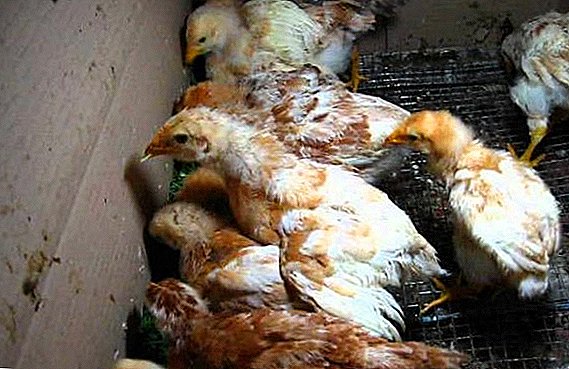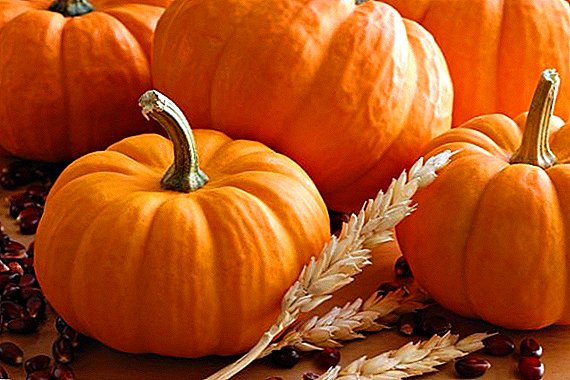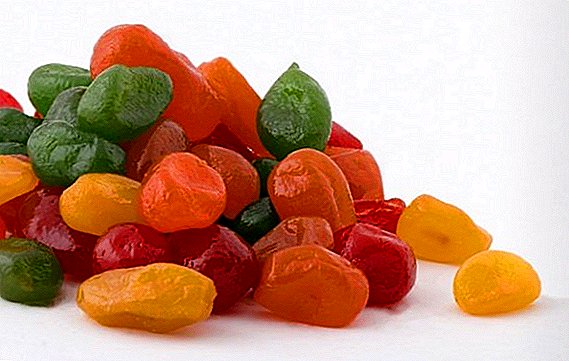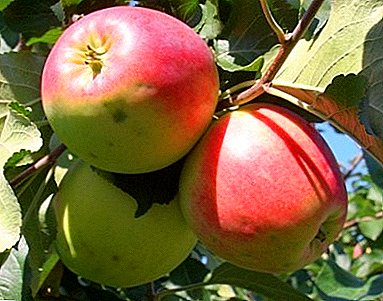 In the world there are at least a thousand different types of ficus, but as the houseplant is most commonly used Benjamin's ficus. Due to the magnificent decorative qualities and unpretentiousness, this flower has a huge number of hybrids, differing in size, color, shape of the crown and many other features.
In the world there are at least a thousand different types of ficus, but as the houseplant is most commonly used Benjamin's ficus. Due to the magnificent decorative qualities and unpretentiousness, this flower has a huge number of hybrids, differing in size, color, shape of the crown and many other features.
But there are problems to which all Benjamins are almost equally affected. In particular, we are talking about such an unpleasant phenomenon as dropping foliage. There can be several reasons for such a disaster, but, as a rule, all of them can be characterized with one phrase - improper care.
Place change
Ficus belongs to the category of indoor plants, which are more easily tolerated transplant than seemingly harmless change of habitat. Even turning the pot around its axis and changing the angle of illumination in this way can cause a “disturbed” dropping of leaves.
Read more about the cultivation of Benjamin ficus, as well as its varieties.
Therefore, a novice florist needs to remember one very important rule: when purchasing a ficus in a store and bringing it into the house, it is necessary to immediately transplant the plant into a new pot, then put it in a pre-allocated place, naturally chosen taking into account the requirements imposed by the ficus to the temperature mode and lighting.  Thus, the number of unpleasant for the flower "crossings" will be minimized.
Thus, the number of unpleasant for the flower "crossings" will be minimized.
If you don’t transplant Benjamin right away, he can start dropping foliage due to a lack of nutrients in the soil. This is another possible cause of the problem.
It is necessary to carefully release the ficus from the ground, trying, if possible, not to disturb and not expose the root system, the more important it is not to damage it. So the flower is easier to take the shock and quickly settle down in a new place.
Important! The newly acquired ficus does not need transshipment, but it needs to be transplanted, with a complete replacement of the land in which it was sold, since the so-called transportation soil is a temporary substrate, which is not suitable for the permanent presence of the plant in it.
Do not be upset if just bought Benjamin dropped a few leaves, for the period of adaptation is normal. Experts recommend buying these flowers in the warm season, in this case, the loss of leaves as a result of the move will be less.
Lack or excess of lighting
The Benjamin Ficus is an evergreen tree whose homeland is the tropics, or to be more precise, the upper tier of tropical forests. It is not surprising that such a plant is very sensitive to lighting conditions.  For a pot, it is necessary to choose a bright place, but the flower should be protected from direct sunlight. A photophilous ficus will most likely respond by dropping foliage to a deficit of light, however, the scorching sun can cause the same reaction.
For a pot, it is necessary to choose a bright place, but the flower should be protected from direct sunlight. A photophilous ficus will most likely respond by dropping foliage to a deficit of light, however, the scorching sun can cause the same reaction.
Important! The lack of light of the variegated Benjamin varieties with motley leaves is especially hard for them; brothers with monophonic foliage, which are closer to a wild ancestor, can stay in partial shade for some time.
Despite the fact that tropical plants, in contrast to the inhabitants of the temperate zone, are focused on a short light day, in the winter, it is still useful for the Ficus to arrange additional lighting.
The best option for Benjamin is a long, 60 cm long, 18–20 W lamp located above the plant at a height of about 30 cm. On cloudy days, it is recommended to keep such a lamp on 24 hours a day, then the plant will not suffer from a lack of lighting.
Violation of temperature
Benjamins can feel comfortably in a fairly wide temperature range. During intensive growth, most of these plants prefer warm air in the range of +25 to +28 ° C, and during the rest period they easily tolerate a decrease in temperature to +15 ° C.  However, the plant is more likely to react to the deviation of the thermometer above or below the specified threshold indicators with fallen leaves.
However, the plant is more likely to react to the deviation of the thermometer above or below the specified threshold indicators with fallen leaves.
Important! For Benjamin, the fundamental importance is not so much the air temperature itself, as its stability and uniform distribution within the room in which the flower is located.
In particular, the cause of leaf fall can be:
- draft;
- finding a pot with a flower in the immediate vicinity of the heat source, when hot air comes from one side or the other point;
- the flow of cold air entering the plant, for example, as a result of opening a window or air vents for ventilation;
- night and daytime temperature differences.
Choosing a place for a houseplant, you need to think over everything in advance so as to eliminate any of the above stresses.
For example, if you put a ficus on the windowsill next to a hot battery and slightly open the window sash to lower the temperature in the room a little, no tricks will save the flower from intensively dropping the leaves. 
Watering errors
Like most indoor plants, the ficus does not like stagnant water in a pot.
When transplanting, it is imperative to ensure that there is sufficient drainage layer and watering only as the top layer of the soil dries.
Read the rules of watering ficus.
But the lack of moisture can cause the fall of the foliage, because in this case it is impossible the assimilation of nutrients from the soil, in addition, the movement of cell sap is limited and the process of photosynthesis is slowed down.
For Benjamin, it is also important that the amount of moisture he receives is correctly changed according to the changes of the season. In autumn and winter, watering should be reduced; in spring and summer the flower needs more water.  So that the earth in the pot does not dry out, it is recommended to periodically carry out the so-called “dry watering” - with a toothpick or fork, carefully loosen the surface of the soil, taking care not to damage the root system.
So that the earth in the pot does not dry out, it is recommended to periodically carry out the so-called “dry watering” - with a toothpick or fork, carefully loosen the surface of the soil, taking care not to damage the root system.
Important! In the tropical forests where Benjamin grows, autumn is a period of drought. Abundant watering at this time of year, the plant perceives as something completely unnatural and in response to such a "disgrace" drops completely healthy leaves.
One of the possible causes of Benjamin leaves falling off is the use of cold water for irrigation. All tropical plants need to be watered with lukewarm water and always well-settled.
Lack of fertilizer
Top dressing of a houseplant is an important element in caring for it, because the amount of soil and, accordingly, the nutrients it has available to the root system is very limited.
Not receiving the necessary components for normal development, the ficus begins to ache and drop foliage.
It will be useful for you to learn how to feed indoor flowers.
Fertilizers should be applied during the period of intensive growth (spring and summer), using universal organic and mineral mixtures. It is best to purchase special fertilizers for ficus or, if not found, - combined additives for non-flowering houseplants.  The usual frequency of feeding is twice a month, but depending on how long the plant has been transplanted (degree of soil depletion), this frequency can be adjusted. Immediately after transplanting fertilizer should not be applied, it can lead to burn of the roots.
The usual frequency of feeding is twice a month, but depending on how long the plant has been transplanted (degree of soil depletion), this frequency can be adjusted. Immediately after transplanting fertilizer should not be applied, it can lead to burn of the roots.
In the wild, tropical plants have virtually no resting phase, their growing season lasts all year round. Once in the temperate zone as room flowers, ficuses began to adapt to new conditions, which is why it is better not to disturb them in the winter.
Did you know? Ficus in the house has numerous useful properties. And if some of them, such as, for example, solving the problem of childlessness (they say that this plant in some magical way helps a woman to get pregnant), can cause a skeptical smile, others are scientifically proven fact. For example, the broad leaves of ficus perfectly purify the air from small particles of dust, and its juice is used in folk medicine as an analgesic and healing agent, as well as a cure for rheumatism and liver diseases.
But if the temperature mode is chosen correctly and the tree is provided with round-the-clock illumination, it does not need rest, which means it can be fed in the winter, using half of the usual dose of fertilizer and half reducing the frequency of their application.
Also during this period, it is necessary to slightly reduce the nitrogen content in the top-dressing, because this element is necessary for intensive growth and a set of green mass, which is still not the case in winter.
Diseases and pests
Unsuccessfully selected conditions for maintaining a flower, in particular, a violation of the lighting regime, humidity and temperature imbalance, can cause the development of various diseases and, as a result, the same foliage abscission.  Most often, Benjamin suffers from attacks of spider mites, scutes, aphids and mealybugs.
Most often, Benjamin suffers from attacks of spider mites, scutes, aphids and mealybugs.
Read more about diseases of ficus, how to deal with spider mites and shields on indoor plants, as well as what fungicides are used in indoor plant growing.
About the attack of these pests is evidenced by the appearance on the leaves (especially from the reverse side) of powdery, resembling to mealy lumps, resinous spots, traces of cobwebs. The affected leaf turns yellow with time, dies off and falls off.
Having discovered a problem, it is necessary first of all to arrange a warm shower with a flower, thoroughly washing each leaf with soapy water (you must first wrap the polyethylene in the pot so that soap and excess water do not get into it).  Spider mite on the ficus If after some time the pest appears again, you should proceed to radical actions in the form of treating the plant with a solution of a suitable insecticide.
Spider mite on the ficus If after some time the pest appears again, you should proceed to radical actions in the form of treating the plant with a solution of a suitable insecticide.
Along with pests, Benjamin is susceptible to some fungal infections, in particular, black and marsupial fungus is dangerous for him. (powdery mildew causative agent). This kind of disease must be fought with fungicides.
In addition to the use of toxic chemicals, it is imperative to analyze the causes of the problem, since, again, under the right conditions of detention, Benjamin usually does not get sick.
Did you know? One of the most famous ficus Benjamin adorns the Royal Botanical Garden in Sri Lanka, which is located near Kandy, the ancient capital of the island. The venerable age of a tree is 140 years, and the area of its crown is completely amazing - two thousand square meters!
One of the most unpleasant diseases faced by the owners of ficus is root rot.. Its peddler is a specific fungus that begins to multiply rapidly in the overmoistened soil.  Ficus root rot Unfortunately, this problem requires “prompt” intervention - an emergency transplant with complete replacement of the ground and removal of rotten roots. Sometimes even such measures are insufficient, and the plant has to be thrown away with the pot.
Ficus root rot Unfortunately, this problem requires “prompt” intervention - an emergency transplant with complete replacement of the ground and removal of rotten roots. Sometimes even such measures are insufficient, and the plant has to be thrown away with the pot.
It is worth noting that changing leaves for ficus is a natural process. The tree itself at home can grow about fifteen years, but the average age of each leaflet is three years.
Having outlived its age, the leaves turn yellow and fall off, so when the plant drops a couple of leaves, there is no reason for panic. But natural aging never leads to massive leaf fall.
Wrong location
Ficus best place near the eastern or western windows. They provide diffused light and protect the plant from the direct rays of the sun.
On how well the pot was located, the preservation of foliage directly depends, because naughty Benjamin gives the owner only one attempt to position himself correctly - for each subsequent you will pay with lost leaves.
Important! The most frequent reason for Benjamin dropping foliage in winter is dry air!
In addition to temperature and lighting, it is also important to ensure that the plant has enough moisture, do not forget, our flower is from the tropics, for which dry air is not at all typical.
In winter, when under the influence of centralized heating the air in the room is overdried, the lack of moisture can be particularly detrimental to the state of ficus.  Therefore, during this period, Benjamin needs to provide abundant leaf spraying every day. As in the case of irrigation, the water should be slightly above room temperature.
Therefore, during this period, Benjamin needs to provide abundant leaf spraying every day. As in the case of irrigation, the water should be slightly above room temperature.
If possible, the pot should be located away from the heating radiator (minimum distance is two meters), but if this is not possible, such as in a city apartment, where the battery is directly under the window, in addition to spraying the leaves, you should also place dishes filled with liquid, or put a terry towel dipped in water and constantly make sure that the water does not evaporate completely.
Familiarize yourself with the most popular types of ficus, in particular with lyre, myocard ficus and rubber ficus (species, diseases and crown formation), also learn how to reproduce ficus at home.
Benjamin is a very beautiful indoor plant, which also has a lot of useful properties. Care for this type of ficus at home is not a big deal, but compliance with basic requirements is mandatory. If an evergreen tree starts dropping foliage, it means that you have made a mistake in something. Fortunately, in most cases, these errors are quite obvious and, as a rule, easy to fix.
Feedback from network users














